Few forms of marketing can boast as much fame or efficiency as email marketing. Its versatility lets it augment inbound outbound strategies alike, fitting into all stages of the sales funnel. Moreover, it continues to offer excellent Return on Investment (ROI), and marketing trends predict its continued prominence.
However, it too presents some notable challenges. Recipients’ inboxes are becoming increasingly cluttered, increasing the chances that a marketer’s email might be ignored or discarded. Similarly, audiences expect increasingly personalized emails that speak to their needs, and won’t easily settle for less.
Thankfully, email automation has long facilitated both personalization and outreach efficiency. Combined, these practices paved the way for behavioral email marketing strategies – which we’ll discuss today.
Defining behavioral email marketing
To do so, let us first define behavioral marketing and explore how one may best approach it.
As the name suggests, behavioral emails are emails personalized for outreach in response to specific behaviors. HubSpot defines the practice as simply “sending targeted emails to your contacts based on their actions and behaviors”. In doing so, they argue, such outreach achieves timeliness, personalization, and action-based relevance and value.
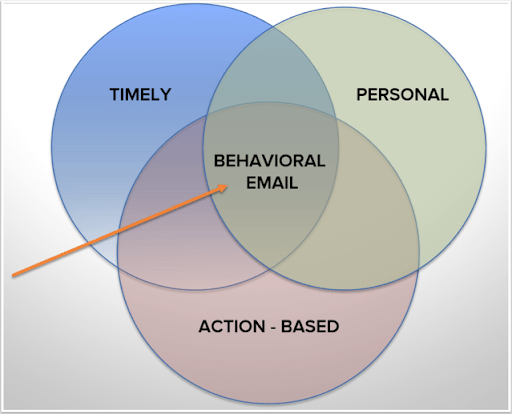
Such emails are typically, but not exclusively, automated in response to specific event triggers. Combined with Customer Relationship Management (CRM) solutions’ behavioral segmentation, email automation solutions can set such desirable triggers for deeper personalization.
Approaching behavioral email marketing
However, as with all marketing endeavors, behavioral email marketing strategies require planning and an explicit problem-solving focus. Here, before delving into the implementation stage, we may briefly outline 3 crucial steps for this initial preparation stage.
1. Crafting an email list
The cornerstone of every email strategy, behavioral or otherwise, lies in a robust email list. Should you not make a perfect list of contacts in advance, any campaign’s effectiveness will suffer.
Fundamental principles and practices in this front include:
- Making your own lists; purchasing lists may be enticing, but it simply isn’t worth your time. For one, recipients won’t respond to unsolicited emails from brands they don’t know. Moreover, the practice carries significant risks of carrier penalties and even legal ramifications.
- Always ensuring consent; instead, you may ensure explicit recipient consent to populate your lists. You may do so through clear offers to opt into your lists across your outreach channels,
- Optimizing Calls to Action (CTAs); ideally, you may do so through fine-tuned, personalized CTAs. Consider each stage of the sales funnel and how your CTAs entice your leads to sign up within their context.
For a visual example of this final point, consider how Backlinko’s Brian Dean does so:

2. Segmenting customers
Having done so, you may then fuel behavioral email marketing strategies through customer segmentation.
This practice is fundamental to crafting buyer personas and mapping customer journeys already, with ample relevant benefits. It also fuels predictive analytics with equally vast potential applications. In this context, it will directly inform your efforts, from which behaviors warrant outreach to which segments welcome it most.
Between your CRM and other audience segmentation tools, consider the following means of segmentation:
- Demographic; a prime means of segmentation, this type offers value for all campaigns.
- Behavioral; an invaluable type for this purpose, behavioral segmentation taps into behavioral pattern insights.
- Value-based; equally valuable in this context, value-based segmentation will further refine audiences based on their final revenue value.
- Geographic; by grouping customers based on location, you can gain more insights into their specific needs and wants.
Should you delve deeper into customer segmentation, there are ample ways to approach it, as SmartInsights illustrates:
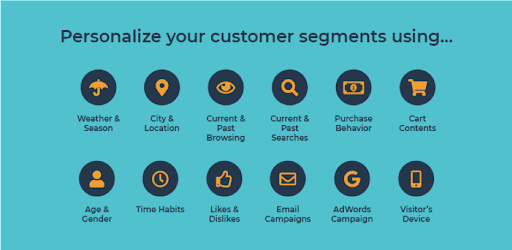
3. Identifying funnel shortcomings
Finally, to clearly establish a problem-solving approach to behavioral marketing, you may examine your marketing funnel to identify exact shortcomings. This is a highly subjective process, understandably, so we may only provide some examples:
- Lead acquisition. If your funnel underperforms in this regard, you may consider focusing on promoting signup forms based on user browsing activity. In addition, you may augment your content marketing strategies to prime audiences for such outreach.
- Lead nurturing. Behavioral email marketing strategies will hinge on proper lead nurturing, so this shortcoming might deserve the most attention. Examine your content marketing strategies and look for behaviors that may warrant outreach to nudge users along toward lead maturity.
- Conversion. Finally, you may simply lack conversions. Behavioral emails can help tremendously in this regard; simply consider how hyper-personalized offers can address your potential customers’ pain points.
Of course, exact phase divisions and examinations, as well as behavioral marketing applications, will depend on your marketing funnel model. For example, Skyword divides theirs into 6 distinct parts
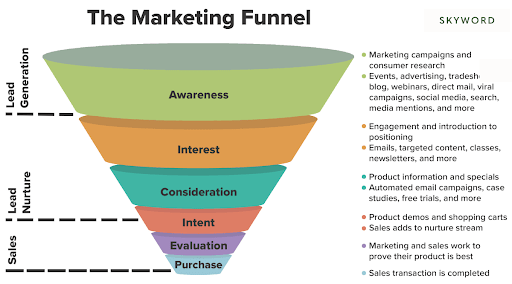
Creating a Behavioral Email Marketing Strategy
With this foundation in order, one may now start crafting a behavioral email marketing strategy. For text economy, we may divide the process into 5 distinct steps as follows.
1. Tracking interactions
The first step lies in insight acquisition; tracking your audiences’ and customers’ interactions with your business.
Among other ways to do so, you may consider the following:
- Your CRM. Your CRM may help reveal such behavioral patterns as repeat purchases, recurring support queries, and so forth. Depending on its focus and capabilities, one’s CRM can serve as a central segmentation and nurturing tool – which makes integrations all the easier.
- Social listening. Similarly, you may use social listening tools to monitor social media discussions that don’t directly tag, mention, or address you. Through such tools, you may also monitor discussions on your field or industry, further informing your content marketing strategies.
- Web activity. Finally, as third-party cookies slowly decline, you may consider first-party, second-party, and third-party web activity monitoring tools. Heat maps can also offer tremendous help in this regard, informing your on-page Search Engine Optimization (SEO) practices in the process.
No matter your choice of tools, this step should build a robust understanding of which behaviors your audiences exhibit.
2. Establishing goals
With this firm grasp of your audiences’ behaviors, you may next establish clear goals. That is, revisit your prior notes and decide what your behavioral email marketing strategies should achieve.
This step, as highlighted above, is strictly subjective and campaign-specific. Nonetheless, approaching it with due care will be crucial to success.
Typical examples of goals and subsequent actions would include:
- Higher lead acquisition rates. Such a goal will require a deep focus on signup CTAs, more enticing landing page copy, and so forth.
- More conversions. Instead, enhancing conversion rates will typically require transactional CTA optimizations, better-personalized offers, and so on.
- Higher customer retention rates. Finally, improving customer retention rates may also often hinge on more relevant offers, more personalized newsletters, and other adjacent optimizations.
Shopify addresses the latter very efficiently, through automated trial extension notifications – including the option for feedback submission:
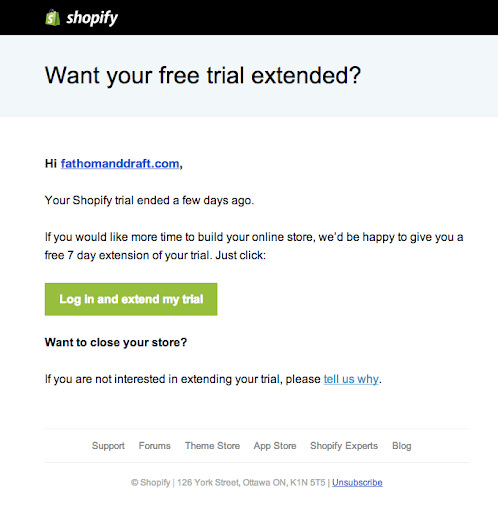
3. Identifying valuable event triggers
On that subject, the final investigative step lies in identifying valuable event triggers. That is, evaluating which events and actions may warrant a personalized, case-appropriate email.
Valuable user events and actions may include:
- List signups
- Completed purchases
- Cart abandonment
- Exits without actions taken
- Subscription expirations and terminations
- User occasions, such as birthdays and signup anniversaries (e.g. VBOUT’s automation platform has named this trigger “Specific date”
- Tag (i.e: when someone is assigned a tag “Paid” -> automatically send them an email after 7 days to leave a product review)
Such events you may follow up with such outreach as, respectively:
- Welcome emails
- Purchase confirmation emails, push notifications, or SMS
- Cart abandonment reminder emails
- Follow-up offer emails
- Reminder and renewal offer emails
- Occasion-appropriate emails, such as wishes, discounts, exclusive offers, and so forth
However, the challenge here lies in which of those make sense for you to focus on. Juxtapose event frequency and potential value with your audience insights and goals to determine which events you should act on.
4. Personalizing the email body
Having done so, you may now implement your behavioral email marketing strategies.
The most crucial element to doing so successfully lies in email body personalization. How exactly you personalize each email will strictly depend on its type and goal, as well as on recipient data. Still, you may consider such universal factors as:
- Your recipients’ sensibilities. This is the reason why audience segmentation is so valuable; different outreach styles resonate with different audience segments. Beyond universal qualities like readability, consider such recipient-dependent elements as length, style and tone, and use of visuals and emojis.
- The intended customer journey. Next, you may further personalize your email body toward facilitating the desirable customer journey. Consider each stage’s context and your customers’ pain points, and cater to both through your emails’ content and offers.
- Email value. Finally, remember to emphasize your emails’ value as strongly as possible. Your recipients need to immediately understand how your email matches their behavior and how valuable its offer is to them.
For a clear example of showcasing value, consider how LinkedIn addresses user absence by visually stressing “what’s new”:
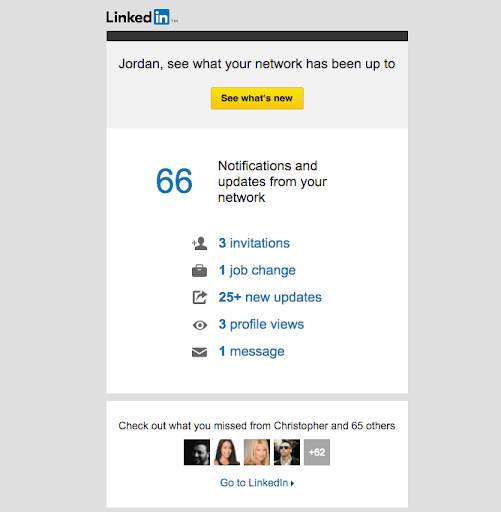
5. Personalizing based on segmentation
Finally, you may further personalize your behavioral email marketing strategies for each recipient segment. This step addresses factors beyond email body itself, and delves into peripheral personalization opportunities.
Among other such elements, consider the following:
- Contextual user information. Initially, depending on outreach type and purpose, you may use further user information beyond their names. You may, for example, cite their past purchases, make location-based suggestions, or reference their social circles as LinkedIn did above.
- Outreach frequency. In addition, you may consider each segment’s sensibilities as regards outreach frequency. Some segments may take kindly to constant outreach, while others may object to more than a weekly email.
- Outreach timing. Finally, your segmentation might inform your emails’ timing. VBOUT suggests that for offers, products and events, the highest open rate comes at the beginning of the work day (6 AM – 10 AM). On the other hand, if emails are related to financial services, the time between 2 PM – 3 PM might be ideal. However, some segments may respond better to other days or even times of day.
In all such cases, it’s highly advisable that you consult your own analytics first and conduct thorough A/B testing. Audiences will differ drastically, so such suggestions can only serve as inspiration and foundations for experimentation.
Conclusion
In summary, behavioral email marketing strategies hinge on hyper-personalized email outreach in response to valuable user actions and behaviors. They thus offer an additional layer of data-driven personalization, allowing email marketing to continue yielding excellent ROI. As personalization across all forms of marketing continues to separate success from failure, these strategies should remain valuable for years to come – and worthy of your consideration.
Author Bio:
Neil Thomson is a digital marketing consultant, freelance copywriter, and aspiring web designer. He’s a frequent content contributor to Movers Development, where he discusses content marketing strategies, SEO and its changing implications, and the surging value of CRM software.
Don’t forget to share this article


